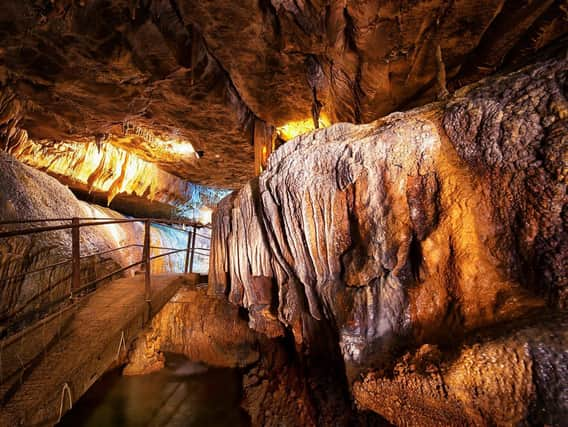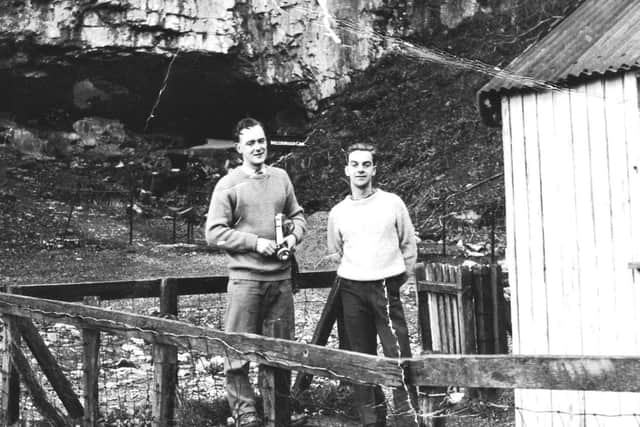Ingleborough Cave re-opens after longest closure in its history


After the longest period of closure since this geological wonder near Clapham was first discovered in 1837, the show cave on the slopes of Ingleborough has re-opened under the watchful gaze of the man who has run the quirky visitor attraction for 65 years.
Ingleborough Cave is very much a family affair - Bob Jarman, a former head of technology at Lancaster University, decided to start showing visitors around the cave system in the 1950s with two friends and a wooden hut for support. Bob's wife Sue came on board and they opened a shop and installed electric lighting before their son Andrew joined them. Now in his 80s, Bob still helps out with the maintenance today.
Advertisement
Hide AdAdvertisement
Hide AdSince the Jarmans took over the lease on the caverns from the Ingleborough estate, they've witnessed some memorable moments, including the opening of the hitherto-mythical underground link to Gaping Gill by divers in 1983, the discovery of a prehistoric woolly rhinoceros tooth by a sixth former working part-time in the caves in 2001, and an epic flood which washed away a walkway in 2015.


Social distancing restrictions mean they have now had to end the tradition of escorted tours and allow visitors to use a self-guided system for the first time in the cave's history.
It was first opened up in 1837 by local landowner James Farrer. The features beyond the entrance were hidden behind large calcite dams, and water had submerged the passages.
After a severe flood, Farrer realised that there must be an outflow of water beyound the dams. He broke down the calcium deposits, released the trapped water and exposed a hidden wonderland of formations and fossils.
Advertisement
Hide AdAdvertisement
Hide AdBy the late 1950s, Bob and his friends were taking time off from their day jobs to show visitors around by the light of Tilley oil lamps, but they realised the spectacular caverns had so much more potential.
"At first they just had a wooden shed and the Tilley lamps, but they gradually put in paths and handrails to make it easier for visitors. Eventually my dad did the wiring for the lighting - he'd worked at Rolls-Royce before," explained Andrew.
Motivating them was the long-held belief by locals and potholers that Ingleborough Cave was the outflow of the stream that feeds Gaping Gill, the vast, 100-metre chasm - if only divers could find the passage that connected them.
They have developed the attraction to the extent that it is now acknowledged as the best show cave in the UK - by no less than a trade association of other show caves around the country.
Advertisement
Hide AdAdvertisement
Hide Ad"We're on a popular route for walkers, so we get the Three Peaks traffic from Ingleborough. We did a bit of advertising and we grew through word of mouth as well. We built the shop, extended it, added more refreshments and toilets, a picnic area, and we want to add in a new building next to improve the facilities."
Hundreds of children visit the caves every day as part of school trips, and, poignantly, so do a large number of pupils from Bradford, who stay at the Ingleborough Hall outdoor centre. Many of them have never been into the countryside before, but, according to Andrew, are 'gripped' by the subterranean world.
Despite harsh Dales winters, the cave's staff - among them a one-legged guide called Chester - open it up daily between February and October, and at weekends at other times. Their Santa's grotto events (Bob himself has been Santa in his younger years) attract over 1,000 people a day and Christmas has become their busiest time of year.
Bob found watching the CCTV stream from the Bank Holiday weekends this spring 'surreal' as it was the first time he could remember the cave being deserted. It remained open during the foot and mouth disease outbreak in 2001 - the same year the ancient tooth was found - and has only occasionally closed for short periods when there is a flood risk during wet weather.
Advertisement
Hide AdAdvertisement
Hide AdThe mythology of the cave system has certainly captured the imagination of Andrew, who followed in his parents' footsteps and also runs the neighbouring nature trail.
"I remember when the rhino tooth was found in 2001 - a 16-year-old girl who worked part-time here was helping Bradford Pothole Club with a dig. She picked up a handful of dirt and spotted something with a peculiar texture. We took it to a museum and they tested it and told us it was from a woolly rhinoceros, which are long-extinct. It's in a museum now."
While the discovery of the link to Gaping Gill was the Holy Grail for the local caving community.
"It was always thought that the system linked up to Gaping Gill, and in 1983 the divers discovered it after 15 hours of rough caving, most of it underwater. They did the trip five or six times after that, but then there was a boulder collapse and it's not accessible any more."
Advertisement
Hide AdAdvertisement
Hide AdWhile Storm Desmond over Christmas 2015 saw the caves flood catastrophically at the same time as water tumbled over Malham Cove for the first time in living memory.
"It flooded right up to the steel door. It was locked, as we'd decided earlier in the day to close when we saw the forecast. It blew the concrete path clean off - it lifted it up. We are very wary about flooding and would never open if there was a risk," added Andrew.
Despite facing a new set of challenges in the era of Covid-19, Bob believes the new regulations offer a chance for visitors to immerse themselves in the caves in a way that they never could have before.
“Previously, visitors have only been able to access the cave on a guided tour, but now, to minimalise contacts between visiting families and groups, we have implemented a self-guiding system with information points throughout the cave. Staff are on hand inside the cave, to give that all important personal and local touch, and to help out where needed. It is quite a unique opportunity, and the sense of adventure that one takes from venturing underground without a guide can really inspire visitors, particularly younger ones”.